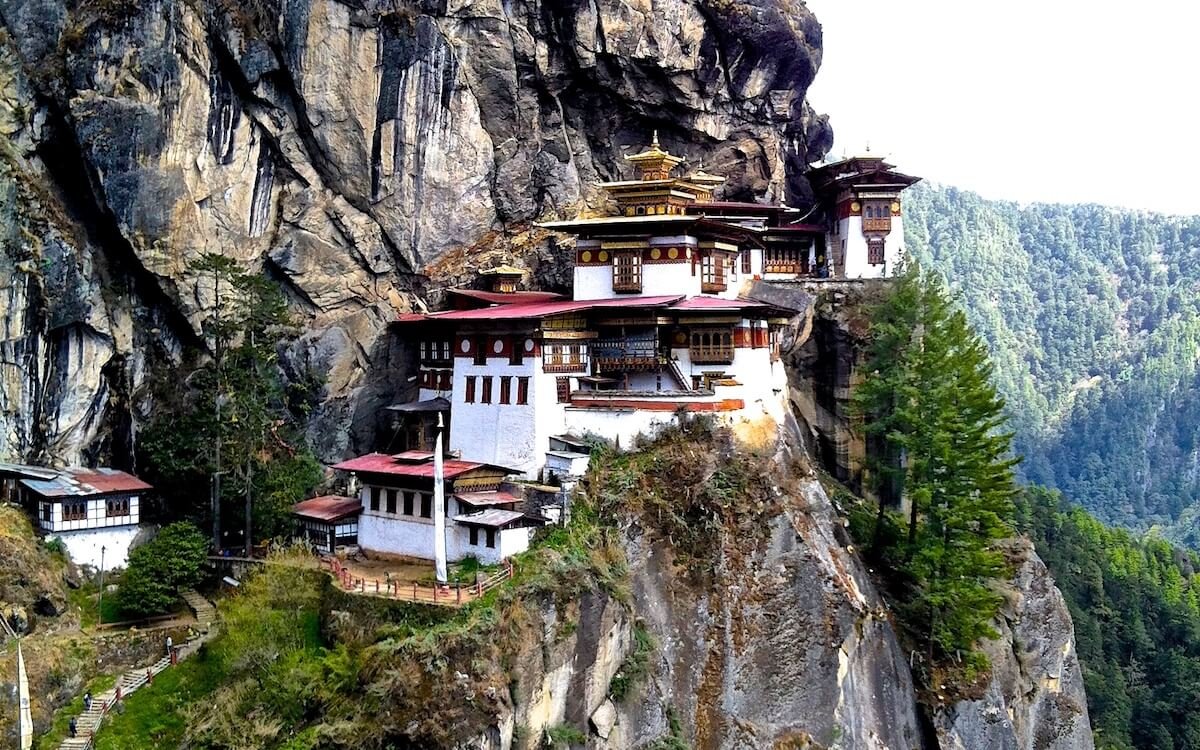Like the Eiffel Tower or the Statue of Liberty, the Tiger’s Nest is one of, if not the defining images of its home nation of Bhutan. For me, it’s one of the places that looks like it came straight from a fantasy novel. It was also one of the main things I was looking forward to seeing once we finally arrived in Bhutan.
Sitting precariously 3,000 metres above the Paro valley, the Paro Taktsang Monastery (Tiger’s Nest Monastery) was built in the late 17th century on the site of a cave set into the cliff. Although we call it the Tiger’s Nest in English, Taktsang more accurately translates to “tigress’ lair” and aptly gets its name from the legend of its founding.
According to that legend, the 8th-century Indian Buddhist master Guru Rinpoche was carried up the mountain on the back of a disciple who had transformed herself into a tigress. Once they arrived, Guru Rinpoche then spent 3 years, 3 months, 3 days and 3 hours meditating in the cave. After he had finished, it became a holy place and became known as Paro Taktsang.

PREPARATION
In order to give ourselves the most time to accomplish the Tiger’s Nest trek, we got up early and left Thimphu around 6am in order to arrive at the base of the mountain around 8am when the site opens to the public. At the entrance, a small collection of stalls was set up for purchasing souvenirs and crafts. There were also carved wooden walking/hiking sticks for sale for 50 Nu ($0.70). Thinking back, I would have found a stick quite useful, had I bought one like Dagney.

Once past the stalls the walk begins slowly. Through the gate, we crossed a couple of fields up to the base of the cliff. Here the locals keep mules and horses which you can hire to carry you upwards on the path. We did not take up this opportunity for a couple of reasons.
First, we were concerned about the animals’ welfare, especially the mules’. Second, you can only go halfway up on the back of the animals anyway. The climb gets too steep for them to safely carry a person after a certain point (which kind of leads back into concern for their welfare). Third, I don’t know if you’ve ever been on the back of a mule or other horse-shaped animal, but if you’re not used to it, then it can be just as painful as walking up on your own in the first place.
Plus, we also wanted to feel the satisfaction of getting to the Tiger’s Nest on our own!

BEGINNING THE Tiger’s Nest Trek
The ground sloped upwards and started to get more vertical. We were officially beginning our ascent!
Although we were nowhere near the Tiger’s Nest at this point, I was excited about the trek ahead. We entered the wooded area that covers the side of the cliff. As it turns out, the main part of the Tiger’s Nest hike is not particularly difficult. It mainly consists of following a gradual incline up the side of the cliff.
Where it begins to get steep, the path starts to zig-zag between the trees to make the slope easier to climb, though there are places where people have made their own path by cutting straight through to the next bend. These paths are easy to follow, but are significantly steeper, so while technically quicker, they can wind up taking just as long depending on your level of fitness (and ability to get lost).

For me, the trek was more of an endurance test. Having lived in the UK for most of my life, I was not used to the altitude. I found myself short of breath much quicker than usual. Dagney, on the other hand, grew up in the mountains of Colorado and was very much enjoying being able to walk rings around me.
He makes it seem like I didn’t struggle, but trust me, I was also struggling. Mine was just a fitness issue, rather than an altitude one.
HALFWAY THERE …
After a couple of hours of climbing (with regular stops to catch my breath), we eventually reached the rest stop that lies halfway along the Tiger’s Nest trek. Here, there are restrooms and an indoor seating area where you can get snacks and refreshments. It’s a good place to take a breather, and also drop off your poor mule if you hired one.

We stopped for about 10-15 minutes and had a cup of tea (naturally) before resuming our hike further up the cliff. Not wanting to stop for too long as the day was getting hotter, we were soon on our way again. There were still a few hundred metres to go before we reached the Tiger’s Nest, both up and down (and then up again, as we found out later).
We spent another couple of hours ascending the cliff. During this time, the Tiger’s Nest had been gradually getting closer and closer. But now, it had disappeared from view. However, as we rounded a corner on an uncharacteristically flat path, we found a viewing platform and there it was – sitting majestically across from us!
Amazingly, we were actually slightly higher up than the Tiger’s Nest was. From the platform, we were looking down at it from across a small valley. Further down the path, a rope bridge crosses the gap next to a waterfall, surrounded by prayer flags.

THE TRICKY PART
This was the part of the trek I had not been looking forward to. In order to get to the Tiger’s Nest Monastery from this route, you have to hike a little further up the mountain. From there, you descend several hundred steps back into the mountain, only to then have to climb back up even more steps on the other side of the rope bridge. The going down part would be okay, but with the thinner air and the increasing heat it was going to be a tough final push to the top.
Sure enough, having gone down the steps to the bottom of the path by the waterfall, both of us were feeling the burn and I needed to catch my breath. Fortunately, the area around the bridge is particularly peaceful and refreshing. There are prayer flags fluttering in the breeze and spray from the waterfall in the air. It was a fantastic recharge, and made us ready for the final part of our journey.

THE FINAL PUSH
Even with that second wind, the stairway to the Tiger’s Nest felt like one of the longest I’d ever encountered. The steps seemed to get steeper as they went on (they don’t, but it felt that way). However, once we’d reached the top it was all worth it.
Once inside the Tiger’s Nest (even more steps to get up there!) we handed over our cameras and phones, and left our shoes at the entrance. We took a final glance across the valley and stepped into the Tiger’s Nest Monastery, instantly feeling relieved to be there. The Bhutanese believe that just stepping over the threshold of the monastery will bring you blessings, so many enter with their hands in prayer.
To see inside, you must join a tour, so we happily joined one led by a monk who lives and works at the Tiger’s Nest Monastery. One of the more incredulous moments came during that tour. I looked across the roof of one of the buildings, and lying there in the sun, looking at me with mild disdain, was a ginger cat!
I know cats like high places, but this seemed a little extreme. The Bhutan we’d so far experienced had been full of stray dogs in the streets, with not a cat in sight. Perhaps they’re all living high up in the monasteries …
PRACTICAL INFORMATION FOR THE TIGER’S NEST MONASTERY TREK
Total Distance: 3 – 4 miles round trip (depending on if you cut through the mountain or go ‘around’ it
Elevation Gain: 1,700 feet (518 metres)
Highest Elevation: 10,232 feet (3119 metres)
Length of time needed: Honestly varies based on fitness level. Most people do it in 3 hours!! We took closer to 8 (yup – but at least we did it!).
Difficulty: That having been said, it is a relatively easy hike, just steep. If you have mobility issues or respiratory problems, though, you might want to reconsider.
Cost: If you have to pay the tourist fee to enter Bhutan, a Tiger’s Nest trek is included in this cost, and can be arranged by your tour guide. Otherwise, entry to Paro Taktsang is free for Bhutanese (who MUST wear national dress) or 500 Ngultrum ($7) for foreign residents and Indian tourists.
Opening Hours: 8:00 to 13:00; 14:00 to 18:00 (this is for entry into the Tiger’s Nest Monastery only, you can still be hiking outside of these times, although you won’t be permitted to start the trek much earlier than 8am).
What to bring: Hiking shoes, comfortable hiking clothes (make sure your arms and legs are covered), LOTS OF WATER, hiking stick. It is also highly recommended to bring medication for nausea as many people (including myself) are affected by the high altitude. I didn’t need this, but it can’t hurt to have just in case.
When to visit: We would recommend spring or fall. Summers can be unbearably hot in Bhutan, even that high up; winters can be exceptionally cold (even if you’re willing to wear layers) and also potentially icy.
YOU MIGHT ALSO BE INTERESTED IN:
– 26 Cultural Places to Visit in Thimphu
– Crossing the Jaigon-Phuentsholing Border
Have you hiked to the Tiger’s Nest in Bhutan? Ever been waylaid by lack of air at high altitude? Have you found a cat in an unusual place? Let us know in the comments!








